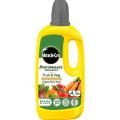

How to grow sweetcorn
Sweetcorn, or maize, is sweet, tender and delicious – especially when cooked as soon as it is picked. Plenty of sun and dry weather are needed for the plants to grow well and to set cobs full of well formed kernels.
Sweetcorn varieties
Hybrid F1 varieties produce the sweetest kernels, and ‘Early Extra Sweet’ is the standard that all new varieties try to beat, although ‘Marika’, ‘Sweet Perfection’ and ‘Early Bird’ are good varieties.
The latest plant breeding has produced enhanced sweetness, with varieties such as ‘Butterscotch’ or ‘Swift’. But if you prefer a less chewy texture, then the tendersweet varieties ‘Lark’ and ‘Extra Tender and Sweet’ are the ones for you.

What you’ll need to start growing sweetcorn
Growing sweetcorn doesn’t require complicated equipment. Here’s what you need:
- Garden fork and spade
- Trowel
- Well-rotted farmyard manure
- General purpose fertiliser
- Liquid feed
- Sweetcorn seeds
- Cloches or clear plastic covers (1 per plant)
For indoor sowing:
- 9cm (3.5in) pots
- Seed sowing compost
How to grow sweetcorn
Cultivation
Choose a position that receives lots of sunshine and is sheltered from strong winds.
Sweetcorn will grow in most soils, providing it is well drained, but holds plenty of moisture. Before sowing or planting, improve the soil so that it is rich in nutrients and organic matter by digging in some well-rotted manure, garden compost or soil improver. Then add a good dressing of a general plant food.
Sowing sweetcorn
Because sweetcorn is pollinated by wind transfer of pollen, the plants must be grown together in a square/rectangular block, rather than a single row or dotted around the garden.
If you wait until late May/early June, you can sow seeds directly in the ground where you want it to grow. You will get better results if the soil is pre-warmed for 2 weeks with cloches or clear plastic covers. Leave the covers in place after sowing until the plants have grown and touch the top.
To get an early start and produce an earlier crop, sow seeds in individual pots or cells filled with a good seed sowing compost in late April or early May and germinate in gentle warmth. Keep the plants indoors until early June, when they will be ready for planting out.
Sow seeds or plant out 45cm (18in) apart in the block.
How to care for sweetcorn
Water the soil thoroughly during prolonged periods of dry weather; this is vital when the plants are establishing and when they are flowering and the cobs are swelling.
Liquid feed every fortnight when the plants start to flower and the cobs begin to swell.
If roots appear at the base of the stem, cover them with soil to improve wind stability.
You can tap the plants when the male flowers (tassels) open to help pollination, as poor pollination will result in poorly filled cobs.
How to harvest sweetcorn
When the silks (female flowers) on top of the cobs have turned chocolate brown, test the kernels for ripeness. Pull back some of the the leaves that cover the cob and press one or two kernels with a thumbnail. If the content is creamy then it’s ripe to eat. If the content is clear, the cob is unripe, so wait. If the content is solid then you’ve left it too long.
Cook as soon as possible after picking in plain water (no salt) and you will taste perfect sweetcorn! Avoid picking more than you need, since cobs that are left in the fridge for a day or two will gradually lose their sweetness.
Common sweetcorn pests
Birds
Birds, especially pigeons, peck at the leaves of young sweetcorn seedlings, often destroying them.
- Grow plants under netting while young. Taller plants are less attractive to birds.
Slugs and snails
Slugs and snails will eat young sweetcorn seedlings, and can be identified by the slime trails that they leave, as well as the damage they do. As the seedlings grow taller they are less at risk from slugs and snails.
- Check plants at night and remove slugs and snails by hand.
- Covering the soil around plants with crushed eggshells or grit may have some effect.
- Scatter environmentally-friendly slug pellets if other methods are insufficient.
Mice
Mice will dig up and eat sweetcorn seeds sown in the ground.
- Cover the ground with a thick layer of prickly holly leaves.
- Start seeds off in pots out of reach of mice and plant them out as seedlings.
Key features of sweetcorn
| Foliage season(s) | Spring, Summer |
|---|---|
| Sunlight | Full sun |
| Soil type | Chalky, Clay, Loamy, Sandy |
| Soil pH | Neutral |
| Soil moisture | Moist but well-drained |
| Ultimate height | Up to 1.8m (6ft) |
| Ultimate spread | Up to 90cm (3ft) |
| Time to ultimate height | 4 months |




